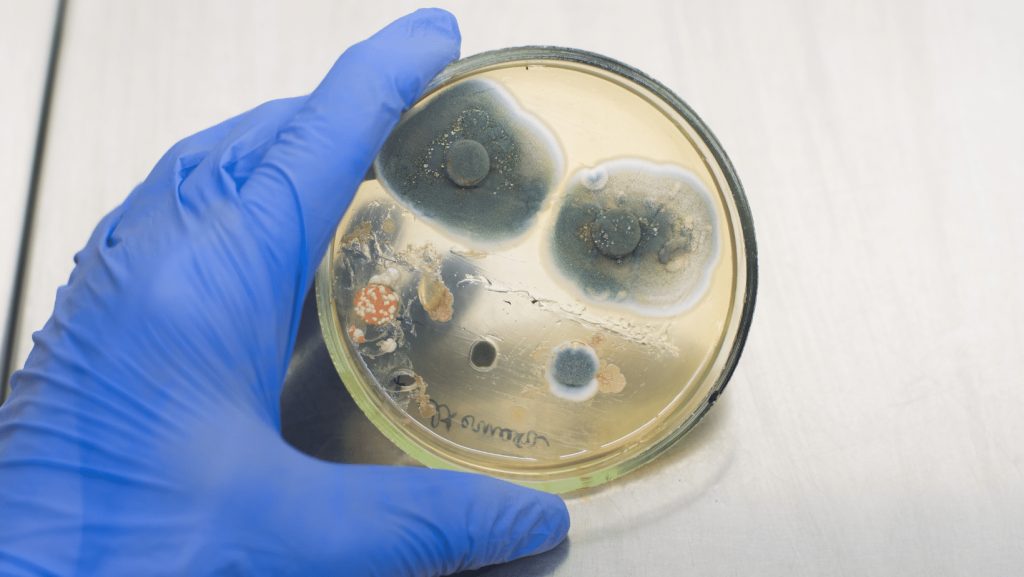As a homeowner, it’s essential to stay vigilant about maintaining a safe and healthy living environment. One potential threat that often goes unnoticed is the presence of mold. Mold is a type of fungus that can grow in various settings and can pose significant risks to both property and human health if left unchecked. Therefore, it’s crucial to conduct comprehensive mold testing and inspection to identify and mitigate any potential threats.

Understanding Mold
It’s important to comprehend the nature of mold and why it can be harmful before delving into mold testing and inspection. Mold is a fungus that grows and reproduces through spores and thrives in moist, humid environments. Although mold is helpful in nature by breaking down organic matter, its presence indoors can be detrimental.
Mold growth indoors can occur due to various factors, including water leaks, high humidity levels, poor ventilation, and inadequate insulation. Common areas where mold can proliferate include basements, bathrooms, kitchens, and attics. Once mold takes hold, it can spread rapidly, compromising structural integrity and causing respiratory issues, allergic reactions, and other health problems in occupants.
Exploring Different Types of Mold Testing
Mold testing plays a crucial role in identifying and mitigating mold-related issues in residential and commercial spaces. Understanding the different types of mold testing methods is essential for maintaining a healthy indoor environment. Explore the diverse approaches to mold testing to ensure thorough assessment and remediation:
Air Quality Testing
Air quality testing is one of the most common methods used to detect mold spores suspended in the air. This method involves sampling the air in different areas of a building to assess the concentration of mold particles. Air samples are collected using specialized equipment such as air pumps and spore traps. Analysis of these samples helps determine the presence and levels of mold contamination.
Surface Sampling
Surface sampling involves collecting samples from various surfaces within a property to detect mold growth. Swabbing, tape lift, and bulk sampling are common surface sampling techniques. Swabbing involves rubbing a sterile swab over a surface to collect mold particles, while tape lift uses adhesive tape to lift mold spores from surfaces. Bulk sampling involves collecting pieces of materials suspected of harboring mold for laboratory analysis.
Visual Inspection
Visual inspection is an initial step in mold testing, wherein trained professionals visually examine indoor areas for signs of mold growth. This includes inspecting walls, ceilings, floors, and other surfaces for visible mold growth, water stains, or discoloration. While visual inspection alone may not provide conclusive evidence of mold presence, it helps identify areas that require further testing and remediation.
Moisture Testing
Moisture testing is essential for identifying the underlying cause of mold growth, as mold thrives in damp environments. This testing involves measuring the moisture levels in building materials such as walls, floors, and ceilings using moisture meters or sensors. Elevated moisture levels indicate potential areas of water intrusion or leakage, which can lead to mold proliferation if left unaddressed.
DNA Testing
DNA testing, also known as molecular testing, is an advanced method used to identify specific types of mold present in a property. This technique involves collecting samples and analyzing the DNA sequences of mold spores to determine their genus and species. DNA testing provides precise identification of mold types, aiding in targeted remediation strategies and allergen management.
The Importance of Mold Testing and Inspection
Mold testing and inspection are crucial steps in identifying and addressing mold issues in residential and commercial properties. These processes involve thorough examinations of the property to assess the extent of mold growth, identify the types of mold present, and determine the underlying causes of moisture accumulation. By conducting comprehensive testing and inspection, property owners can:
Identify Hidden Mold
Mold often grows in hidden areas such as behind walls, under flooring, or within HVAC systems. Professional testing and inspection can uncover these hidden sources of mold, preventing further damage to the property.
Assess Health Risks
Certain types of mold can pose serious health risks, especially to individuals with allergies or respiratory conditions. Testing helps identify the specific strains of mold present and assess the associated health risks for occupants.
Determine the Source of Moisture
Mold requires moisture to thrive, and identifying the source of moisture is crucial for effective mold remediation. Through inspection, experts can pinpoint areas of water intrusion or humidity buildup, allowing for targeted repairs and prevention strategies.
Ensure Effective Remediation
Mold remediation efforts are most successful when based on accurate testing and inspection results. By understanding the extent of mold growth and the underlying causes, property owners can implement appropriate remediation measures to eliminate mold and prevent recurrence.
Potential Threats Uncovered by Mold Testing and Inspection
Structural Damage
Prolonged exposure to mold can weaken the structural components of a building, leading to decay, warping, and even collapse in severe cases. Mold testing and inspection can identify areas of structural damage caused by mold growth, allowing for timely repairs to prevent further deterioration.
Indoor Air Quality Issues
Mold spores can become airborne and circulate throughout indoor spaces, compromising indoor air quality. Poor indoor air quality can exacerbate respiratory problems and contribute to various health issues among occupants. Testing and inspection help identify sources of indoor air pollution, including mold contamination, enabling property owners to take corrective actions to improve air quality.
Legal and Financial Liabilities
Failure to address mold issues promptly can result in legal and financial liabilities for property owners. Occupants may file lawsuits alleging negligence or seeking compensation for health-related damages caused by mold exposure. Additionally, insurance companies may deny coverage for mold-related claims if property owners cannot provide evidence of proactive testing and remediation efforts.
Occupant Health Risks
Mold exposure can trigger allergic reactions, exacerbate asthma symptoms, and cause respiratory infections in susceptible individuals. Children, the elderly, and individuals with weakened immune systems are particularly vulnerable to the health effects of mold exposure. Mold testing and inspection help identify potential health risks associated with mold contamination, allowing property owners to take measures to protect occupants’ health and well-being.
Steps for Mitigation and Prevention
Professional Mold Remediation
Upon identifying mold contamination through testing and inspection, property owners should enlist the services of certified mold remediation professionals. These experts have the knowledge, experience, and equipment necessary to safely and effectively remove mold from the property while minimizing the risk of cross-contamination.
Addressing Moisture Issues
To prevent mold recurrence, property owners must address underlying moisture issues that contribute to mold growth. This may involve repairing leaks, improving ventilation, installing dehumidifiers, or implementing waterproofing measures to prevent water intrusion.
Regular Maintenance and Monitoring
Ongoing maintenance and monitoring are essential for preventing mold problems in residential and commercial properties. Property owners should conduct regular inspections for signs of moisture accumulation, promptly address any leaks or water damage, and ensure proper ventilation and humidity control to create an inhospitable environment for mold growth.
Common FAQs About Mold Inspection
Can you test the air in your house for mold?
Yes, checking the air in your home for mold is a very important step in finding mold problems. This is useful knowledge about air quality because it helps find out how many mold spores are in the air inside.
How can I test for mold in my house?
There are different ways to check your home for mold, such as air sampling, surface sampling, and bulk samples. Even though there are do-it-yourself kits available, it’s usually best to get help from a professional for accurate and thorough testing.
How do you assess mold in the indoor environment?
Professionals who are certified must check their indoor surroundings thoroughly in order to find mold. It is their job to look for mold that can be seen, collect samples of the air with special tools, and sometimes take samples from the surface to find out what kind of mold is growing and how big it is.
How do you test for mold exposure?
A medical evaluation, like blood or skin tests, is usually needed to find mold-related antibodies when someone has been exposed to mold. Mold screening and testing are important, but it’s also important to deal with the natural source of exposure.
What to Do If You Find Mold
Mold in the home can be scary, but the best way to make sure everyone stays healthy is to act quickly and after doing some research. It is very important that you clean up professionally if your mold specialist finds signs of mold or mycotoxins during an inspection. In order to properly deal with mold problems, here is what you need to know.
Are All Types of Mold Harmful?
Mold is not always dangerous to people. Mold really is a normal part of the world, and you can find it both inside and outside. Some molds make mycotoxins, which are poisonous if eaten, breathed in, or exposed to them for a long time. However, not all molds make these poisons.
Besides that, mold can be more harmful to some people than others. Most healthy people may not have any major health problems from being exposed to small amounts of mold. However people with allergies, asthma, or weak immune systems can have allergy reactions or breathing problems even when they are exposed to small amounts of mold.
Why Professional Oversight Matters
Qualified Mold specialist
Bring your knowledge to the cleanup process to ensure the steps are safe and effective. If you try to fix the problem without professional help, you might make it worse and increase the risk of health problems. For complete and effective mold removal, you must trust the knowledge of a licensed professional.
Health Problems and Getting Medical Help
Seeking medical assistance is of the utmost importance if you have any reason to believe that mold poisoning is impacting you or someone you care about. Mold exposure can result in a variety of health concerns, including allergies, respiratory troubles, and other conditions. When it comes to evaluating and addressing potential health implications, it is recommended to seek the advice of healthcare specialists who specialize in environmental health or toxicology.
What to Do Right Away
Contact Professionals
Talk to qualified mold removal professionals to find out how bad the problem is and make a plan for how to fix it.
Avoid DIY Remediation
Do not give in to the urge to clean up mold on your own. Professional expertise makes sure that the removal is complete and safe.
Health Evaluation
If you have worries about your health because of mold, you should see a doctor right away for a full review and advice.
Create a Remediation Plan
Work together with the pros who do mold removal to make a thorough plan for how to deal with and get rid of the mold problem.
Preventive Measures
Take steps to stop mold from growing again, like fixing any water leaks or other moisture problems in your home.
Measurement and Evaluation of Mold: How Much Time Is Required?
Several things affect how long the mold inspection and testing process takes: the size of the property, the amount of mold growth, the number of samples taken, and the type of testing used. A normal mold check and testing process for a small to medium-sized home takes about an hour to three hours on average. It may take longer for bigger buildings.
The samples taken during the check need to be analyzed in a lab. This can take an extra one to five days, based on how long it takes the lab to do the tests. The whole process, which includes the inspection and lab analysis, usually takes between a few hours and a few days. However, it’s important to get a more exact estimate from the mold inspection service provider based on your unique needs.
Conclusion
Furthermore, checking and inspecting for mold are important parts of keeping an indoor setting safe and healthy. In conclusion, mold tests and inspections are essential for keeping indoor settings safe and healthy. Customers can protect their homes from the harmful effects of mold growth by using careful testing methods and thorough checks.
As a persistent and often sneaky presence, mold can pose serious threats to both property damage and human health if not dealt with. Individuals can effectively prevent the start of mold-related problems by prioritizing regular testing and inspection practices. This lowers the possibility of expensive damage and negative health effects. By doing this, homes can find possible problems early on, figure out how bad mold infestations are, and take the right steps to fix them.
Choose Mold Testing Houston for Trustworthy Mold Testing Services
For residents of The Woodlands and surrounding areas, ensuring the safety of your home and family is paramount. That’s where we, Mold Testing Houston, come in. With our expertise and state-of-the-art equipment, we offer comprehensive mold testing and inspection services to help homeowners identify and mitigate mold-related risks. Don’t wait until it’s too late. Contact us today to schedule your mold inspection and take the first step toward a healthier living environment.





